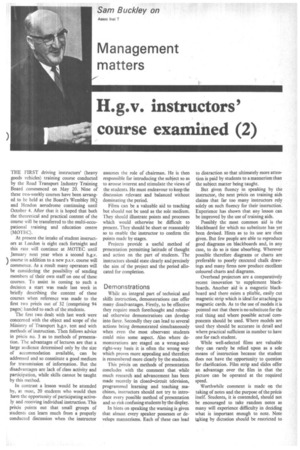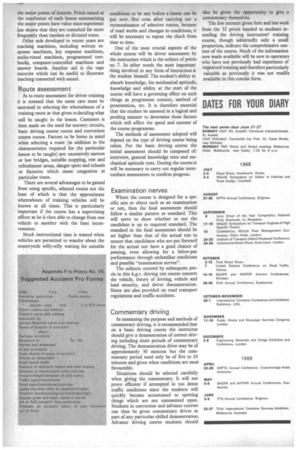H.g.v. instructors' course examined (2)
Page 157

Page 158

If you've noticed an error in this article please click here to report it so we can fix it.
THE FIRST driving instructors' (heavy goods vehicles) training course conducted by the Road Transport Industry Training Board commenced on May 20. Nine of these two-weekly courses have been arranged to be held at the Board's Wembley HQ and Hendon aerodrome continuing until October 4. After that it is hoped that both the theoretical and practical content of the course will be transferred to the multi-occupational training and education centre (MOTEC).
At present the intake of student instructors at London is eight each fortnight and this rate will continue at MOTEC until January next year when a second h.g.v. '1 course in addition to a new p.s.v. course will commence. As a result many operators will be considering the possibility of sending members of their own staff on one of these courses. To assist in corning to such a decision a start was made last week in briefly describing the content of these courses when reference was made to the first two precis out of 32 (comprising 94 pages) handed to each of the students.
The first two dealt with last week were concerned with the object and scope of the Ministry of Transport h.g.v. test and with methods of instruction. Then follows advice in precis no. 3 as to methods of presentation. The advantages of lectures are that a large audience determined only by the size of accommodation available, can be addressed and so constitute a good medium for transmission of information. But the disadvantages are lack of class activity and participation, while skills cannot be taught by this method.
In contrast a lesson would be attended by, at most, 20 students who would then have the opportunity of participating actively and receiving individual instruction. This precis points out that small groups of students can learn much from a properly conducted discussion when the instructor assumes the role of chairman. He is then responsible for introducing the subject so as to arouse interest and stimulate the views of the students. He must endeavour to keep the discussion relevant and balanced without dominating the period.
Films can be a valuable aid to teaching but should not be used as the sole medium. They should illustrate points and processes which would otherwise be difficult to present. They should be short or reasonably so to enable the instructor to confirm the points made by stages.
Projects provide a useful method of presentation permitting latitude of thought and action on the part of students. The instructors should state clearly and precisely the aim of the project and the period allocated for completion.
Demonstrations
While an integral part of technical and skills instruction, demonstrations can offer many disadvantages. Firstly, to be effective they require much forethought and rehearsal otherwise demonstrations can develop into farce. Secondly they can lead to several actions being demonstrated simultaneously when even the most observant students could miss some aspect. Also where demonstrations are staged on a wrong-andright-way basis it is often the wrong way which proves more appealing and therefore is remembered more clearly by the students.
This precis on methods of presentation concludes with the comment that while much research and advancement has been made recently in closed—circuit television, programmed learning and teaching machines, instructors should not try to introduce every possible method of presentation and so risk confusing students by the display.
In hints on speaking the warning is given that almost every speaker possesses or develops mannerisms. Each of these can lead to distraction so that ultimately more attention is paid by students to a mannerism than the subject matter being taught.
But given fluency in speaking by the instructor, the next precis on training aids claims that far too many instructors rely solely on such fluency for their instruction. Experience has shown that any lesson can be improved by the use of training aids.
Possibly the most common aid is the blackboard for which no substitute has yet been devised. Hints as to its use are then given. But few people are able to reproduce good diagrams on blackboards and, in any case, to do so is time absorbing. Wherever possible therefore diagrams or charts are preferable to poorly executed chalk drawings and many firms now produce excellent coloured charts and diagrams.
Overhead projectors are a comparatively recent innovation 'to supplement blackboards. Another aid is a magnetic blackboard and there exists a pliable, easily cut magnetic strip which is ideal for attaching to magnetic cards. As to the use of models it is pointed out that there is no substitute for the real thing and where possible actual components should be used. Where models are used they should be accurate in detail and where practical sufficient in number to have one for each student.
While well-selected films are valuable they can rarely be relied upon as a sole means of instruction because the student does not have the opportunity to question for clarification. Film strip and slides offer an advantage over the film in that the picture can be operated at the required speed.
Worthwhile comment is made on the taking of notes and the purpose of the preciS itself. Students, it is contended, should not be encouraged to take random notes as many will experience difficulty in deciding what is important enough to note. Note taking by dictation should be restricted to the major points of interest. Precis issued at the conclusion of each lesson summarising the major points have value since experience has shown that they are consulted far more frequently than random or dictated notes.
Other aids developed in recent years are teaching machines, including written response machines, key response machines, audio-visual machines, programmed textbooks, computer-controlled machines and answer boards. Another aid is the tape recorder which can be useful to illustrate teaching connected with sound.
Route assessment
As to route assessment for driver training it is stressed that the same care must be exercised in selecting the whereabouts of a training route as that given to deciding what will be taught in the lesson. Comment is then made on the need for nursery circuits, basic driving course routes and conversion course routes. Factors to be borne in mind when selecting a route (in addition to the characteristics required for the particular lesson to be taught) are: excessively narrow or low bridges, suitable stopping, rest and refreshment areas, danger spots and schools or factories which cause congestion at particular times.
There are several advantages to be gained from using specific, selected routes not the least of which is that the approximate whereabouts of training vehicles will be known at all times. This is particularly important if the course has a supervising officer as he is then able to change from one vehicle to another with the least inconvenience.
Much instructional time is wasted when vehicles are permitted to wander about the countryside willy-nilly waiting for suitable conditions to be met before a lesson can be put over. But even after carrying out a reconnaissance of selective routes, because of road works and changes in conditions, it will be necessary to repeat the check from time to time.
One of the most crucial aspects of the whole course will be driver assessment by the instructors which is the subject of precis no. 7. In other words the most important thing involved in any form of instruction is the student himself. The student's ability to absorb knowledge, his mechanical aptitude, knowledge and ability at the start of the course will have a governing effect on such things as programme content, method of presentation, etc. It is therefore essential that the student be assessed in a logical and probing manner to determine those factors which will affect the speed and content of the course programme.
The methods of assessment adopted will depend on the type of driving course being taken. For the basic driving course the initial assessment should be composed of: interview, general knowledge tests and mechanical aptitude tests. During the course it will be necessary to carry out regular intermediate assessments to confirm progress.
Examination nerves
Where the course is designed for a specific aim or object such as an examination or test, then the final assessment should follow a similar pattern or standard. This will serve to show whether or not the candidate is up to required standard. The standard in the final assessment should be set higher than that of the actual test to ensure that candidates who are put forward for the actual test have a good chance of passing, even allowing for a below-par performance through unfamiliar conditions and possible "examination nerves".
The subjects covered by subsequent precis in this h.g.v. driving test course concern the vehicle, theory of driving, vehicle and load security, and driver documentation. Notes are also provided on road transport regulations and traffic accidents.
Commentary driving
In examining the purpose and methods of commentary driving, it is recommended that on a basic driving course the instructor should give a demonstration of correct driving including short periods of commentary driving. The demonstration drive may be of approximately 30 minutes but the commentary period need only be of five to 10 minutes and given when conditions are most favourable.
Situations should be selected carefully when giving the commentary. It will not prove efficient if attempted in too dense traffic conditions since the students will quickly become accustomed to spotting things which are not commented upon. Students in conversion and advance courses can then be given commentary drives as part of any particular skilled demonstration. Advance driving course students should also be given the opportunity to give a commentary themselves.
The few extracts given here and last week from the 32 precis handed to students attending the driving instructors' training course, though admittedly only a small proportion, indicate the comprehensive content of the course. Much of the information now made available will be new to operators who have not previously had experience of organized training and therefore particularly valuable as previously it was not readily available in this concise form.








































































































































































































